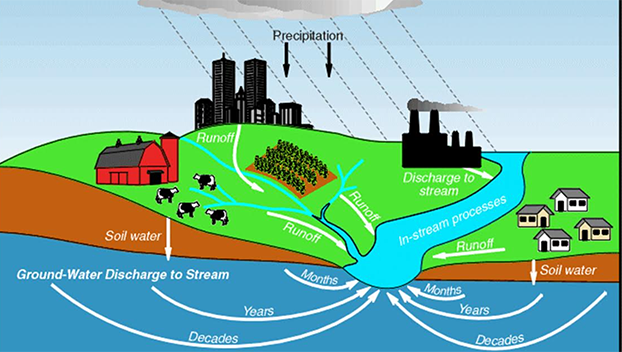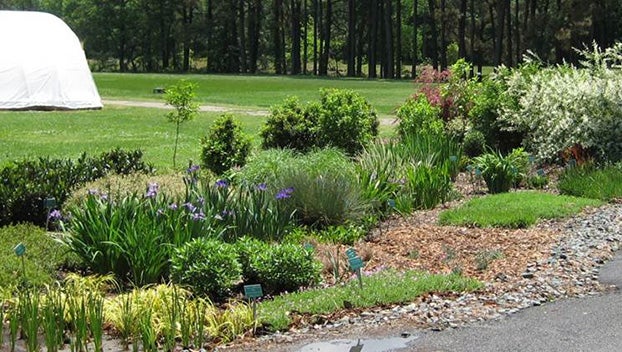MASTER GARDENER — Rain gardens are repository for storm water runoff
Published 12:02 am Thursday, August 11, 2022

- According to the EPA, it estimates 70 percent of the pollution in our streams, rivers and lakes is carried there by storm water. (md.water.usgs.gov)
|
Getting your Trinity Audio player ready...
|
Fellow gardeners, good news!
According to local weather experts, our weather pattern has finally shifted from one of extremely hot and arid conditions for several weeks, almost back to normal for this time of year, where rain chances are increased for afternoon showers.
Hopefully, our “new” weather pattern will stay put long enough to provide much needed relief from drought conditions many areas in SETX are experiencing!
As we now have increased rain chances for our area, let’s take this opportunity to discuss rain gardens which can make exceptional use of rainwater and storm water runoff.
Storm water runoff is a huge problem for many of us in SETX, me included. After thunderstorms or daily bouts of afternoon showers, rainwater runs down roofs, across driveways, parking lots, streets and yards, all of which eventually drains into municipal storm drains or in my case, slowly drains into Cow Bayou and onward, finally reaching the Sabine River.
Storm water flowing over these surfaces gathers many pollutants, such as oil & gas residue, pesticides, chemicals, livestock and pet wastes, fertilizers, and a litany of other contaminants which flow into drains and ditches.
According to the EPA, it estimates 70 percent of the pollution in our streams, rivers and lakes is carried there by storm water.
A rain garden is a shallow depression in the landscape or yard, typically planted with varieties of deep-rooted native flowers, shrubs and grasses which can handle marsh-like conditions for a few days.
The plants “don’t mind getting their feet wet” for a short time. This type of garden is designed to collect and hold rainwater runoff from downspouts, driveways, and sidewalks, while allowing the water to slowly percolate back into the soil. During this process, the soil and plants remove pollutants naturally over time.

Using a rain garden for storm water management can be effective, as well as beautiful. (Courtesy of Texas A&M).
Rain gardens don’t have to be large or complicated, make them any size you like! Begin creating a rain garden by selecting an area of your landscape which has a natural depression.
Next, direct the gutters from your home to drain into this area, otherwise you may need to funnel rainwater into this area.
Typically, rain gardens should not be placed within 15 to 20 feet from foundations to prevent flooding, and it is not recommended for rain gardens to be planted near septic systems.
Before planting a rain garden, perform a percolation test on the soil to see how long it retains water. It should not retain water for more than 2 or 3 days.
If the soil is not a well-draining soil, amend it with a mix of sand (50 percent), topsoil (20-30 percent) and organic compost (20-30 percent).
Dig the area to loosen the existing soil and mix in the above mixture to a depth of about 2 feet before planting.
Choosing the right plants is key to creating a successful rain garden, as they must tolerate standing in water for a few days and be capable of withstanding dryer conditions.
When planted with the right types of plants, rain gardens attract birds, butterflies, and other wildlife. Native plants and wildflowers are certainly good choices since they are highly adaptable and have fewer disease and insect problems.
Some plants to consider – ferns, iris, swamp milkweed, asters, black-eyed Susan, Bluestar (Amsonia), Joe Pye weed, Coneflowers, Summersweet, Daylilies, Coral Bells, Cardinal Flower and Texas Star Hibiscus, to name a few.
So, you may ask, what are the key the benefits of installing a rain garden?
- Conserves municipal water resources by reducing the need for irrigation
- Establishes a natural permeation of rainwater into the soil
- Moderates’ pollutant runoff – fertilizers, pesticides, animal waste, and chemicals from lawns, roofs, and driveway
- Improves local water quality
- Reduces garden maintenance
- Increases enjoyment and garden aesthetic
And finally, installing a rain garden is not going increase the local mosquito population (they are doing just fine), if the soil where the rain garden is placed allows water to soak into the ground within 48 to 72 hours, as this doesn’t allow enough time for the mosquito’s life stages. Sorry Mosquitos!
Now my fellow gardeners, let’s go out and grow ourselves a greener, more sustainable world, one plant at a time!
Master Gardener
Orange County Master Gardener certification classes will begin with orientation Aug. 25.
Classes are Thursday evenings.
The class fee is $150, which includes training handbook, supplies and speakers’ fees.
Please visit our website, then click JOIN MG link for more information.
John Green is a Certified Texas Master Gardener. If you have gardening questions or need more information, contact the Orange County Master Gardeners Helpline at 409-882-7010 or visit txmg.org/orange, Orange County Texas Master Gardeners Association on Facebook or email extension@co.orange.tx.us.





